ENG | Logarex Slide Rules: A Collectors Perspective
Introduction
This article aims to organize and share observations from my collection of Logarex slide rules. There are two valuable resources in Czech on this topic, other than online auctions (aukro, ebay, etsy) with high quality photos:
- logaro.cz - catalogue of Czechoslovak slide rules, few articles
- log.sustr.net - virtual slide rules, articles
Logarex was a manufacturing facility of known brand KOH-I-NOOR HARDMUTH (KIN) company specialized in making plastic rules and drawing templates based in České Budějovice, Czech Republic. There have been disputes regarding the Koh-I-Noor brand, which saw its operations split during or after World War II into separate entities: KIN North America, KIN Italy, and KIN/L.C. Hardmuth. These companies had overlapping product portfolios, including pencils, office supplies (such as pencils, ink, pins, stapplers), and art supplies (water colors, brushes, chalks, charcoal pencils, …), along with technical drawing tools (rulers, mechanical pencils).
Curiously Koh-I-Noor brand was not used in period from 1950s to early 1990s (pencils had L.C.Hardmuth or BohemiaWorks brand, drawing templates and rules had Logarex brand). KIN slides rules were produced by French Graphoplex and rebranded by KIN USA. Logarex has Koh-I-Noor branding only in some Czech manuals and on price tags and very rarely on slide rule itself - but on Ebay I found some with manual in Spanish with Koh-I-Noor brand on both manual and even slide rule, likely made for South America.
The article does not cover terminology, how to use slide rules and working principles - these were previously described in Reinventing logarithms and slide rule article.
Whereas the previous article was based on my research, consulted with ChatGPT, this one is based almost entirely on sites linked above and some personal observations. Sources about Logarex/Koh-I-Noor history: 1,2,3
Numbering
The numbering scheme of Logarex slide rules follows a consistent pattern:
- 271xx model feature 10cm scales, slide rule is always few centimeters longer
- 272xx are 12.5cm
- 273xx are 15cm
- 274xx are 25cm
- 275xx are 50cm
- 276xx are 25cm often duplex or special and seem to be later models
- 4542- prefix indicates early models
- Slide rules not following this pattern or without model number are the very earliest
Exception to this scheme is 27101 with 25cm module (seems identical to 27401) and I also found two versions of 4542-27201 - one with Rietz layout and one “Electro”. For likely complete list of Logarex slide rule, see unofficial cataloque on logaro.cz site dedicated to Czechoslovak slide rules.
Timeline
Pinpointing the exact dates for slide rule models is challenging. Models produced after roughly 1962 have the date embossed at the end of the slider, and it seems that older and newer models were manufactured simultaneously on different machines at the same time. My assumption based on Etsy search results is that models described as 50s/early 60s were produced until 1972 when they were replaced by models ending by letter -X.
Generations may be marked by change in model number, the addion of roman numberal suffix such as -II, or extra dot after model number. Sadly, some slide rules have different mechanical design, but the same number.
Prehistory
Logarex started making slide rules in early 1950s. Before this era, the most common slide rules in Czechoslovakia were wooden models made by Nesler, Meissner, and Faber-Castell. There were some smaller, local companies. For example my oldest slide rule is Faber-Castell 375 made in December 1929, heritage from my grand-uncle.
50s and Early 60s
The earliest slide rules were made from hard, brittle, shiny, white plastic (according to 3 it’s PMMA). The manufacturing process utilized rather simple plastic profiles that were cut with a saw, with grooves and ridges milled and visible surfaces polished. Scales were printed, and surfaces were treated with a varnish protecting print.
The first slide rules featured scales with a distinctive ‘railway’ design, characterized by ticks of three different lenghts and a continuous line running over the shortest ticks. This design was later abandoned.
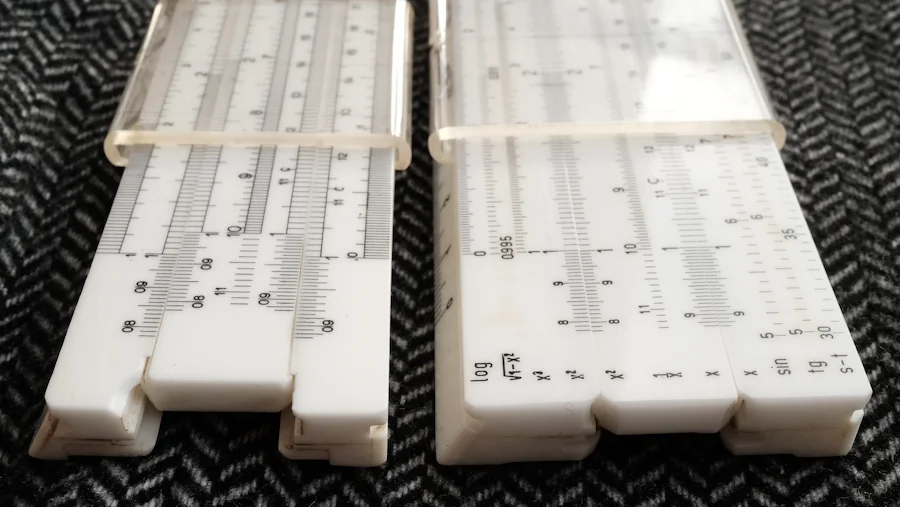 Logarex 220651-8401 and 27403-II are ones with the early design. Note that frame is made from several parts. I kind of like aesthetic of these.
Logarex 220651-8401 and 27403-II are ones with the early design. Note that frame is made from several parts. I kind of like aesthetic of these.
Overall, the material is nice, however early slide rules have their issues:
- Brittle material led to chipped ends of scales on stocks or corners.
- Glue holding transparent cursors on the back often disintegrated over time, resulting in loose or lost cursors.
- Manufacturing tolerances varied. Some rules have high friction, whereas some are too lose. For instance, the Darmstadt models were designed for reversible slides to bring LL scales to the front, which is not possible, when slider does not have perfectly symmetric ridges which are supposed to fit into a groove.
One slide rule I have (4542-27201) was stored in “suboptimal” conditions and was used heavily so print is pale, close to illegible, slider is scratched, whole slide rule is bend along it’s long axis and back part is deformed likely due to high temperature. Moving slide requires brute force.
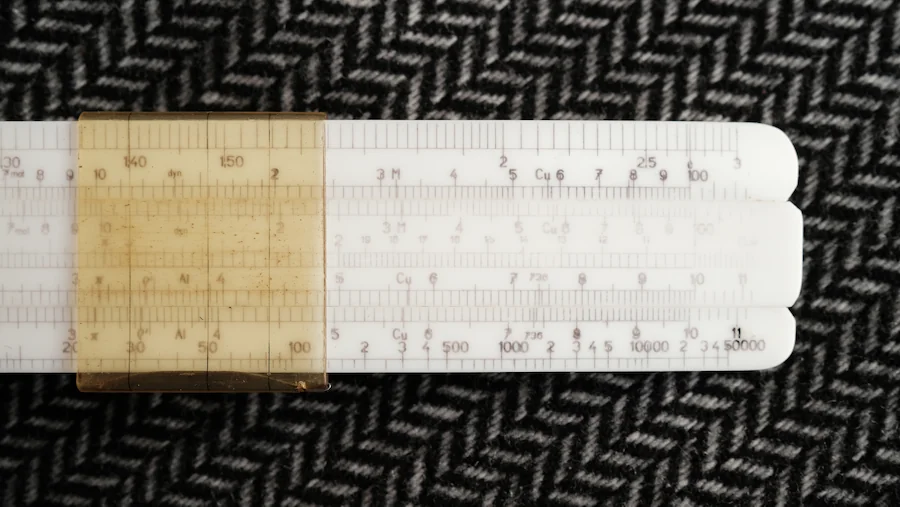 Logarex 4542-27201 (without model number printed) which seems targeted at eletrotechnics with a bit original scale layout. Sadly it’s in horrible condition and pretty useless.
Logarex 4542-27201 (without model number printed) which seems targeted at eletrotechnics with a bit original scale layout. Sadly it’s in horrible condition and pretty useless.
Old slide rules seem to be (nearly) always either “System Rietz” or “System Darmstadt” with closed design - it means that back side is one piece covering slider. Earliest models seem to be 2206518401, 4542-27201 and few others with 4542 prefix.
Cursors are flat, C-shaped Plexiglass with a W-shaped spring on top fitting into grooves on the slide rule’s edges. Some early 220651-8401 have metal cursor, but these are rare.
The cases are typically cardboard and color paper (black, red, blue, …) for 25cm slide rules. These are usually in horrible condition or not present. Smaller ones are in leather pouches.
Common slide rules:
- 220651-8401 - 25cm old slide rule with ‘railway’ scales, system Rietz (although it’s not explicitly written on it), not so common.
- 27203 Darmstadt - 12.5cm extremely common slide rule. 4542 version differs very slightly in dimensions.
- 27302 Darmstadt - 15cm version of above, quite common, more legible
- 4542-27402 - 25cm version of above, but without L scale, not so common
- 27402-II Darmstadt - 25cm updated version with addional L and S-T scales, extremely common, somewhat thick and heavy
I dated 27402-II to this period and I really assume it’s among the earlier designs, but I found image of one made in May 1972 with modern cursor on Etsy presenting it in great condition in a nice gallery.
Early to mid 60s
First duplex slide rules are introduced: 27205 and 27602 and later 27602-II with more scales. They have different construction, material and manufacturing process, compared to earlier ones. Material seems to be hard, white polystyrene (according to 3), it’s PVC. Scales and numbers are embossed into slide rule, painted and then excess paint seems to be removed by polishing process. Bridges holding two stocks together seems to be protecting end of grooves from chipping. Cursors are made from two yellowish-brown plastic pieces with a few ridges for better grip, two sheets of Plexiglass, held together by eight screws. With 23 scales, they are among the most advanced slide rules produced by Logarex.
Red color was introduced for scale extensions and for scales running backwards.
There are new case designs:
- Plastic pouches where one side is trasparent with a flap
- Plastic pouches without a flap
- Soft, flexible white or green plastic boxes
Though maybe not aesthetically pleasing, these designs were functional and durable. Slide rules from the previous era continued to be available.
Common slide rules:
- 27602-II 25cm duplex, S-T scale divided to minutes
- 27205 12.5cm duplex, S-T scale divided decimally (smaller brother)
These two models are later named “Exponent”, which is reference to Fepur 40/45 Exponent slide rule. Fepur made maybe three slide rules models before and merged with Logarex.
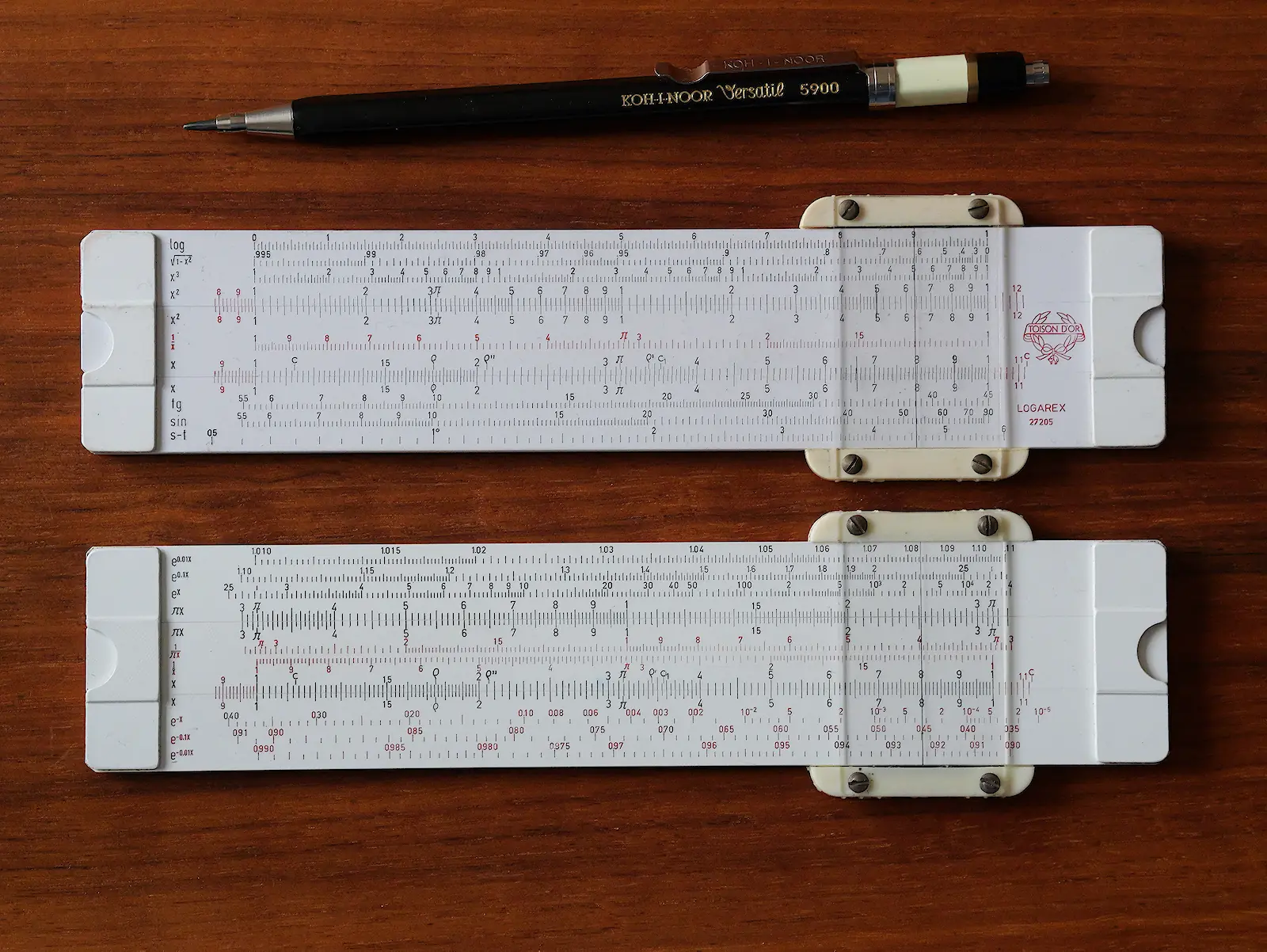 Logarex 27205 duplex 12.5cm slide rule from Jan 1962 (other has no date). The most advanced “pocket” slide rule made in Czechoslovakia
Logarex 27205 duplex 12.5cm slide rule from Jan 1962 (other has no date). The most advanced “pocket” slide rule made in Czechoslovakia
Later 60s and 70s
The most interesting models are from this era, though the quality of some feels just cheap and uninspiring. Models 27401-X Rietz, 27403-X Darmstadt, 27402-X Electro, 27406 Finlog share mechanical parts and differ only in print making for example Rietz model partially empty. Logarex 27606 has weird scale layout without any log scale. But this is just a personal opinion. Bridges on these are at one side and upper side sometimes have chipped ends of scales. Technology used for these models seem to be again print and thin layer of warnish, but material is dfferent. I guess white PVC.
27602-II is still manufactured, but with different cursors, no grooves on outer edges, slightly creamy color, less shiny surface and less visible embossing and it’s labeled “Exponent”. Similar design is used on other slide rules, but sometimes with different bridges holding slide rule together.
New case this of this era is faux leather pouch (sometimes used even for 25cm models), but soft plastic boxes are still used and cursors are made completely of Plexiglass with rigdes on the edge for better grip.
There is one slide rule that stands out: Logarex 27251 Darmstadt that is made as a single piece without any glue. It’s more similar to foreign slide rules.
Common slide rules:
- 27403-X Darmstadt - scales like 27402-II, but open design with one-side bridges, made likely from PVC. Some scales going in reverse are red, slider is slightly yellowish on front side. Extremely common. Compared to version II, some scales are not extended or not so much (trigonometric scales, LL scales), it does not have centimeter rule and it’s significantly lighter.
- 27602-II Exponent with different cursor (Plexiglass clip), less common
- 27608 Dr Pleskot - not so common, not the most advanced, but unique and beginner’s friendly. Trigonometric scales have red numbers in reverse (sin vs cos, tan vs cotg) and it has some guidance in a form of arrows which scale to read against which. Finally, someone was clever enough to print A and L scale on the back, so LL scales could be used without turning slider. However P scale is missing. Back side has basically printed manual, rather than typical constants. Suffers from smeared green paint at the end of slider
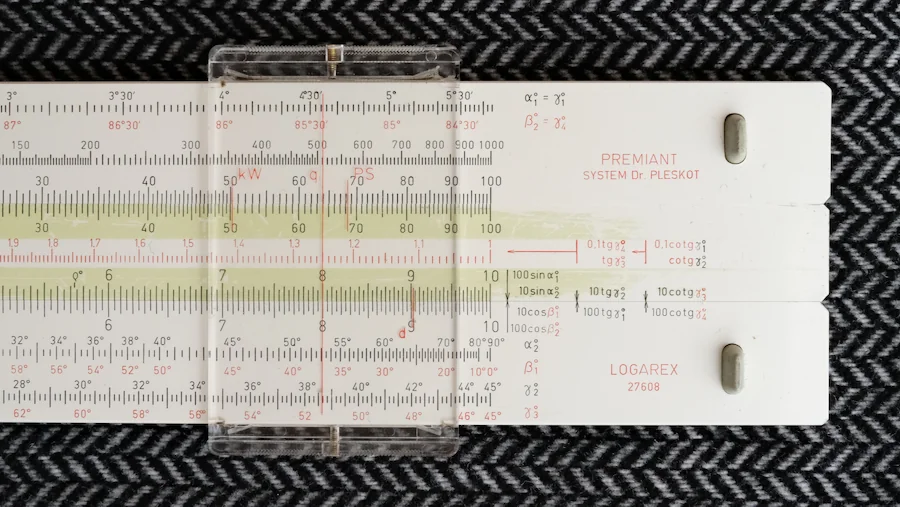 Logarex 27608 Premiant / Dr Pleskot with arrows marking scales which belong together.
Logarex 27608 Premiant / Dr Pleskot with arrows marking scales which belong together.
80s
Slide rule production rapidly declined in late 70s and ceased with end of year 1982, because in late 70s there were made obsolete by pocket electronic calculators that became cheap and available.
Observations
- First date embossed on slide rule I’ve seen is 1/62 on Logarex 27205
- Old cursor was used at least till 2/66 on Logarex 27403-II
- New cursor was used at least from 5/67 on Logarex 27203
- First -X model observed is 11/72
- I assume that slide rule 27451 does not exist. There is manual, but later manual is shared for 27251, 27203 and 27302 - these are all Darmstadt type slide rules.
- There are some errors on slide rules:
- Logarex 27203 has B scale marked as x instead of x^2
- Logarex 27402-II has twice 1.1 instead of 1.11 on upper LL scale
- My Logarex 27251 has table of constant printed upside down
Summary for foreign slide rule collectors
The Most Common Ones
The most common slide rules (based on watching auctions) seem to be ones labeled as “System Darmstadt” by far. They all have flaws.
- 27402-II suffers from manufacturing tolerances and slides too easily, too hard or slide is not reversible.
- 27402-X is absolutely uninspiring and yellow color may be very pale. If user holds cursor on flat part, hairline can be scratched against the body. I don’t see any reason why D scale is not added to the back side. Despite it feels cheap, it does not have any flaws.
- 27203 is a bit hard to read. It seems that it was manufactured for a long time with different cursors. Models with 4542 prefix differ in material and slighly in dimension, but it’s hard to notice - sliders and cursors are not interchangable between models. They may suffer from tolerances issue.
I assume that 27402-II, 27203 and 27302 models were made from early sixties or late fifties to early seventies, when they were replaced by 27402-X and 27251 models.
Somewhat less common are 27602-II, 27205 and 27302 (15cm variant of 27203). Also 220651-8401 was likely the most popular model in 50s.
The Interesting Ones
- 27205 and 27602-II - They have enough scales, quality is not bad, they should be not hard to find
- 220651-8401 or 27402-II - Unique material, the first one is nicer, the second one is extremelly common.
- 27608 Dr.Pleskot - Basic, self-documenting and a bit unique slide rule. Not that easy to find.
- 27251 Darmstadt - Addresses some issues of 27203 (cursors on the back are not glued, but held mechanically. There’s no L scale, but CI is easier to read. It adds red numbers for cos/cotg). Not easy to find. On the other hand it’s not special in any way when compared to some German models.
- 27103 Rietz - A tiny 10cm Rietz-like slide rule (ST+S scales are against A which makes them even shorter and basically useless for angles above 60deg). The most interesting part is dwarf size.
- 4542-27501 - 50cm beast. Scales are L,K,A [B,CI,C],D,S,T,LL3. Back side is blank. S scale is against A from 35’ to 90°. T scale is 5°46’ to 45°.
Which slide rules to collect? I don’t have an answer. There are several factors:
- Aesthetics: some slide rules are nice, some are not. It’s up to you. It can be interesting to compare different eras, materials and manufacturers, but designs seem to converge. Also later models seem similar to Aristo, UTO, … My preference are 2206518401 and 27403-II
- Practicality: It depends. I don’t like slide rules that are hard to read, on the other hand small ones are portable. Rietz type seems more appropriate for small format. 27203 12.5cm Darmstadt slide rule feels too small, 15cm 27302 is ok. Because I prefer having LL0X for exponential decay, DF,CF,CIF scales for proportions and P scale, 27205, 27602-II and Logarex 27607-I Studio Technik (which is almost exact copy of Aristo 0968 Studio) are ones I would use preferably.
- Different manufacturers for comparison
Things to watch for
- Chipped ends of stocks caused by extended slider bend upwards. Slight damage is not critical, but sometimes scales are damaged. This may happen if slide rule falls.
- Missing main cursor
- Missing static cursors on the back. Some closed slide rules have grooves with hairlines printed on their edges - typically there are 3 scales on the back of the slider, groove on the one side is narrower and allows reading middle scale. Some (are supposed to) have transparent plastic pieces so all scales can be read on both ends.
Comparison with Foreign Models
I don’t want to this, based on a single sample from other manufacturers. But anyways.
- UTO 601 - My piece suffers from blurred paint, slides a bit harder. Without blurred paint, it would be nice.
- Aristo Nr89 - The slide action is uncomfortably hard
- Meissner KG >Multi< - Somewhat weird slide rule similar to system Darmstadt, but without windows on the back. Paint worn out a bit.
- British Thornton AA010 - much better legibility than anything else (wider font, surface is not shiny and it’s a bit darker), my favorite modern slide rule. But creamy color is uneven, scales are not extended and cursor is not the best one.
- Pickett N4 aluminum slides too well except when it’s close to “home” position where slide action is awkward. The legibility is quite good for such a small font, but they layout is too cramped and cluttered. Best case thou - plastic insert in leather pouch. For me it has niche use.
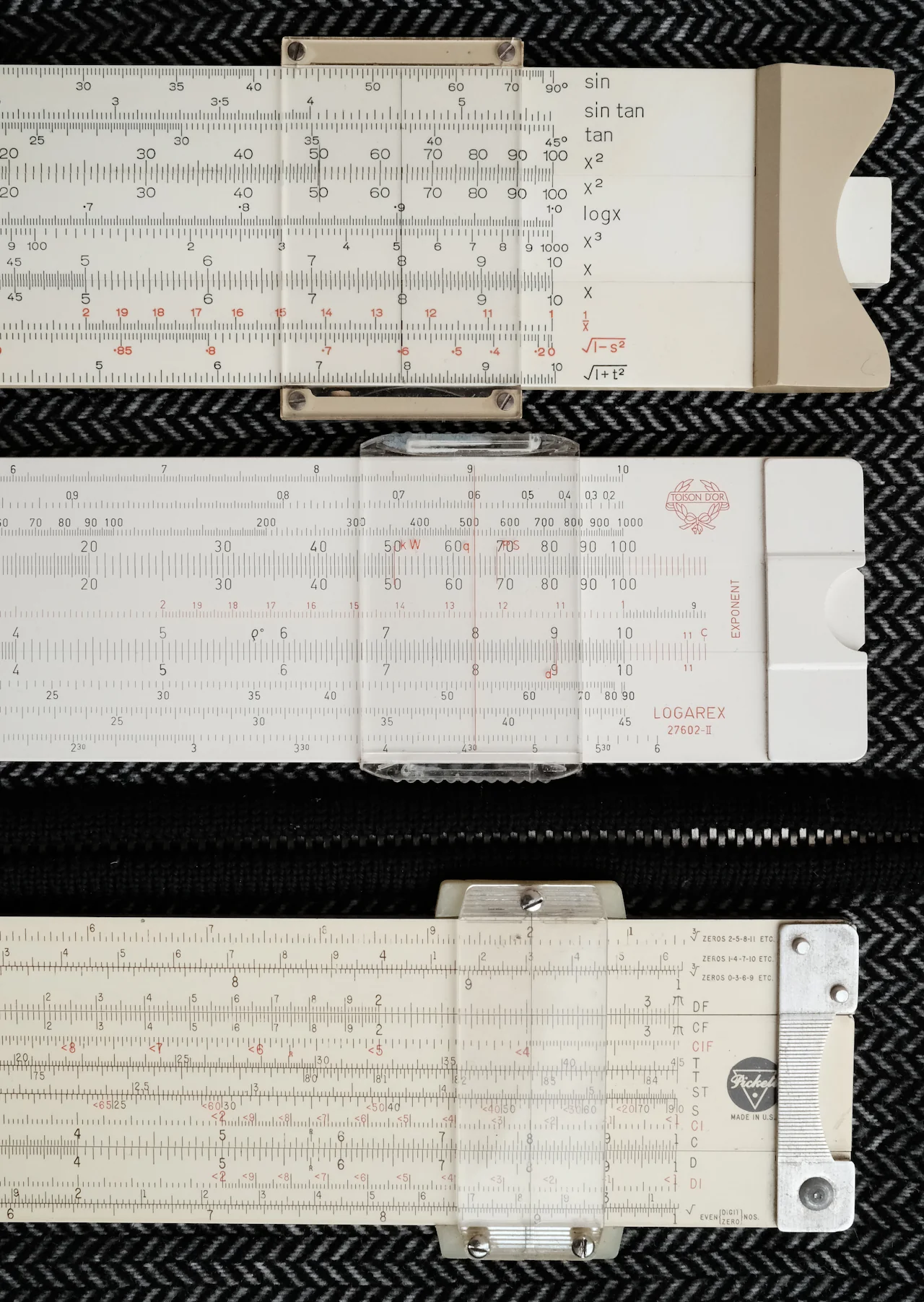 British Thornton AA010 Comprehensive, Logarex 27602-II Exponent (later), Pickett N4-T side-by-side. Difference in legibility is quite obvious from photos (Pickett has 35 scales!).
British Thornton AA010 Comprehensive, Logarex 27602-II Exponent (later), Pickett N4-T side-by-side. Difference in legibility is quite obvious from photos (Pickett has 35 scales!).
It’s important to note that foreign slide rules tend to be somewhat expensive, largely due to shipping costs on eBay (and VAT when imported to EU). As a result, cheaper models might not offer good value for money and even then shipping can be easily half of the final cost.
From this comparison, it seems that the quality of Logarex slide rules is quite reasonable, especially considering that all the above-mentioned foreign slide rules are from the late 60s (Pickett is actually 1959 or 1960 version). Blurred paint is an issue with some Logarex models, but it’s much more pronounced in the UTO. Mechanical tolerances in Logarex rules seem to have improved by the late 60s (could be a coincidence), and they usually slide quite well if they are clean and treated with a little of soap.
It’s interesting to compare legibility. Logarex slide rule seem to have slightly thinner ticks. It seems that what matters is color - it should be slightly creamy, visible embossing of text creates reflections and in general it’s better when surface does not have any visible texture, but it’s not shiny either. Logarex, UTO and Aristo seem similar in that regard. Thornton and Meissner are doing this better - they almost seem bigger with less dense ticks.
Maintenance
All slide rules made by Logarex are plastic, although different kind of plastics. My experience is that they can be cleaned by a toothbrush, warm (not hot) water and detergents used to hand-clean dishes (Ajax, …) - I would be careful with ones containing abrasive powder and using toothbrush on cursor. Ball pen ink can be cleaned with alcohol or isopropyl alcohol, but be careful - sometimes paint can go off too! Although to me it happened only with one made likely from celluloid by unknown company. Anyways, Czech manual for 27602-II slide rule explicitly warns against use of alcohol and organic solvents and their vapors. Faber Castell has warning about alcohol in their manuals as well, stating it’s harmless to plastics, but it can dissolve print.
Cursor can be usually cleaned with a paper tissue or piece of paper put underneath.
Slide rules should be protected from sunlight, temperatures above 50C, scratching and mechanical stress.
Sliding action can be improved by soap or wax (although I would be careful with some soft, syntetic candle waxes of dubious composition and smell).
Manuals
These manuals are in Czech.
- Logarex 27451 & 27251, system Darmstadt
- Logarex 27602 & 27205, (Exponent)
Additional notes, corrections
After reading this article, early slide rules are made from PERSPEX (PMMA). Later ones are Astralon (PVC) and not polystyrene as I initially thought. Slide rules made by injection molding are made from polystyrene. I’m just not sure which ones - i assume it’s 27251 with the body made from a single piece.
Slide rules I want
Early 510622-8401 with metal cursor- Logarex 27607-I Studio Technik I.
- Logarex 27302 in good condition (no missing cursor etc)
- Logarex 27407 ultrarare slide rule with unique scales (same as 2/83 W-scales)
- Logarex 27403-III Darmstadt (newer variant of 27403-II)
- Fepur 30/26 Geodet and 40/45 Exponent
(4542-)27501 Rietz (50cm long)- Faber Castell 2/83(N) for reasonable price
References
- Historie KOH-I-NOOR HARDMUTH, Emanuela Petráň
- KOH-I-NOOR USA
- Rozhovor s panem Václavem Kojanem z Firmy Logarex v Českých Budějovicích (následně závod podniku KOH-I-NOOR), Ing. Karel Chaloupka, https://log.sustr.net/clanky/kojan.php
- logaro.cz - cataloque of Czechoslovak slide rules, few articles
- log.sustr.net - virtual slide rules, articles